List of Authors
>>About this blog
Recent blog post
|
[Yotaro]
August 30, 2013 10:00
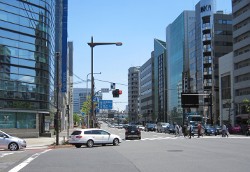 In August 1893, Shohachi Kimura (1893-1958), famous for Kafu Nagai's “Illoha”, a beef shop at 1-1 Yoshikawacho, Nihonbashi-ku (currently Higashi Nihonbashi, Chuo-ku) In August 1893, Iroha was the eighth child of a businessman Shohei Kimura. This year marks the 120th anniversary of birth of the Chinese zodiac sign. In August 1893, Shohachi Kimura (1893-1958), famous for Kafu Nagai's “Illoha”, a beef shop at 1-1 Yoshikawacho, Nihonbashi-ku (currently Higashi Nihonbashi, Chuo-ku) In August 1893, Iroha was the eighth child of a businessman Shohei Kimura. This year marks the 120th anniversary of birth of the Chinese zodiac sign.
It seems that there were as many as 30 brothers and sisters in Shohachi, but many were blessed with artistic heavens, sister Eiko (Akebono), brother Sota, and brother Soju are writers, and brother Sotoji is a film director. I am named as a director. Shohachi's main business is oil paintings that played an active part in Fuzankai, Sodosha, and Shunyokai, but it was also very popular in the field of illustrations, and was a cultural person who performed various activities such as stage art and hobby kouta. In particular, he has demonstrated his talent in writing, and has left many wonderful sentences that talked about "hometown" Tokyo as a genuine Tokyo person born in Tokyo and loves Tokyo. (Souhachi Kimura, a literary artist, was awarded the Art Academy Prize for "Tokyo Shigeshoki" after his death. In addition, Kodansha has published a total of eight volumes of "Kimura Shohachi Complete Works". )
By the way, where is Yoshikawa-cho 1 now? After the war, the painter himself lamented the transformation, saying, "... Where did you born ... Even if you actually go to that area, you can hardly find ..." ("Ryogoku Past") Is it a little south of the Ryogoku Post Office (2-27-12 Higashi-Nihonbashi), east of the Yasukuni Dori Asakusabashi intersection? (Although he said, "Ryogoku" refers to the west side of Ryogoku Bridge, the Chuo-ku side. It seems that there was also the name of Ryogoku Yoshikawa-cho. You can feel a remnants of the post office name. The east of the bridge is "East Ryogoku", and now "Ryogoku" comes to mind only this Sumida-ku side. ) Here, "A corner shop with a wide frontage and a glass door on the front of the second floor with five-colored glass" ("Ryogoku neighborhood") was the eighth branch of "Iroha" beef shop (= Ushinabeya) . Inside the store, the entrance is depicted in one of the representative works, "Beef Store Bookhouse".
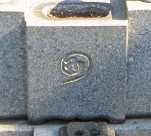 This year, the 120th anniversary of his birth, a retrospective exhibition was held at the Tokyo Station Gallery in Chiyoda-ku, next door. Unfortunately, there seems to be no special event in the birthplace of Chuo-ku, where he loved, so on August 21, the day of birth, I thought that it was the former Yokawacho, and hit the street iron I hit the street iron. I played a large kite of a warrior painting that I bought for two yen and fifty yen of a tiger boy who hit a five-sixed nails on the streets of Koyako. This year, the 120th anniversary of his birth, a retrospective exhibition was held at the Tokyo Station Gallery in Chiyoda-ku, next door. Unfortunately, there seems to be no special event in the birthplace of Chuo-ku, where he loved, so on August 21, the day of birth, I thought that it was the former Yokawacho, and hit the street iron I hit the street iron. I played a large kite of a warrior painting that I bought for two yen and fifty yen of a tiger boy who hit a five-sixed nails on the streets of Koyako.
[On the photo] From Asakusabashi intersection, look toward Ryogokubashi.
[Lower photo] The signature of the artist carved on the tomb of Enji, Suginami Ward
[Akira Makibuchi / Sharakusai]
August 10, 2013 09:00
On the south side of Nihonbashi is the Nihonbashi Miyuki Building, which houses the Nihonbashi Central Branch of the Bank of Tokyo-Mitsubishi UFJ. There is an old entrance left toward the Nomura Securities Building on the northeast side. This is the entrance and exit of the former Murai Bank in this place (above photo).
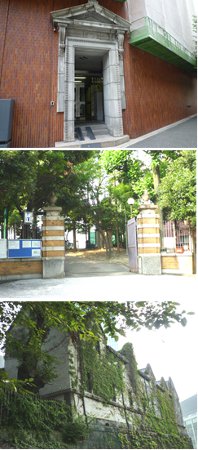 Murai Bank was founded by Kichibee Murai, a native of Kyoto, in 1864 (1864)-1926 (1926). During the Meiji era, Murai was called the "Oriental Tobacco King" due to the privatization of tobacco, and manufactured and sold Japan's first double-cut tobacco "Sunrise" to build a huge wealth. It is said that he competed for advertising with "Tengu tobacco" by Matsuhei Iwaya, Ginza, Tokyo. Murai Bank was founded by Kichibee Murai, a native of Kyoto, in 1864 (1864)-1926 (1926). During the Meiji era, Murai was called the "Oriental Tobacco King" due to the privatization of tobacco, and manufactured and sold Japan's first double-cut tobacco "Sunrise" to build a huge wealth. It is said that he competed for advertising with "Tengu tobacco" by Matsuhei Iwaya, Ginza, Tokyo.
In 1904 (1904), when tobacco became a monopoly system, he gained enormous compensation and founded Murai Bank and advanced to Tokyo mainly in Kyoto. Initially, the branch was Odenmacho 1-chome, but in 1913 (1913), it was relocated to the Nihonbashi triangular area to Japan's first reinforced concrete building in the Renaissance style. In 1927, the financial crisis broke down and went bankrupt. In addition, he established Murai Kisen, Murai Mining, and Imperial Paper.
Kichibee Murai's residence was located on the site of Hibiya High School in Nagata-cho, Chiyoda-ku, near Hie-jinja Shrine. In 1912 (1912), he moved to this land of about 5,000 tsubo, and completed in 1919 (1919), the building was completed in 1919 (1919). It was called "Sanno-so". After the bankruptcies, it was relocated as the Shoin of Enryaku-ji Temple.
Murai died suddenly in 1926 (1926), and his residence was sold to Tokyo due to bankruptcies in 1927 (1927), and in 1929 (1929), Prefectural Ichinaka (currently Hibiya High School) moved from Nishi Hibiya. The gate pillar of the old residence is still used as the main gate of the school building (center of the photo). The old art warehouse facing Shinsaka (commonly called late hill) on the Mexican embassy side is also maintained as a museum and still exists (bottom photo).
By the way, Hibiya High School moved to 3-15 Tsukiji, Kyobashi-ku (currently around the Togaku Building) in June 1887 as Tokyo Prefectural Junior High School in June 1887, and was renamed Tokyo Prefectural Junior High School in 1899 (1899). Until March, it was located in Tsukiji for about 12 years. The prefectural craft school (now Tokyo Metropolitan Crafts High School) opened on the site in April 1907 (1907). @ Akira Makibuchi
[Sam]
August 8, 2013 09:00
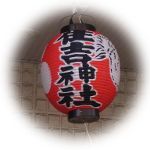 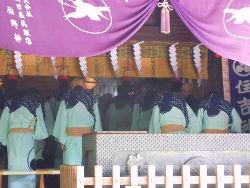 August 6th and 7th are the Reisai Festival of Sumiyoshi-jinja Shirine, guardian god in Tsukuda, Tsukishima, Kachidoki and Harumi districts. August 6th and 7th are the Reisai Festival of Sumiyoshi-jinja Shirine, guardian god in Tsukuda, Tsukishima, Kachidoki and Harumi districts.
This year's "Yin Festival" means the city is different from the hustle and bustle of Reitaisai festival, once every three years.
On August 6, a large festival ceremony was held at 11:00 on August 6, and Kagura dedication was held quietly at 14:30/16:30/19:00 on August 7.
Still, from August 7th, 14th, 2012, Sumiyoshi Tsukuda, the caretaker who wore Reitaisai festival's "Align" in 2012, conveys the unique thoughts and manners of local festivals, the strong bonds and the spirit of handing down.
(upper left of the photo)
✎One of the essential things for Reitaisai festival is the new tone of a yukata called "Soroi".
Miya portable shrine can't carry it in Tsukuda unless he wears a uniform coat and white tabi.
Women can't carry Miya portable shrine, but I hear that women can participate only in the Miyamoto Town Association <Senuki> carrying of miniature shrines.
Tsukuda Island (Tsukuda 1-chome) has an organization called Sumiyoshi Tsukuda, which consists of only boys consisting of <Kamimachi>, Nibe <Shitamachi> and Sanbe <Azumacho>, and is involved in the whole religious service held at shrines as well as in the Reisai Festival of Sumiyoshi-jinja Shirine.
The members of Sumiyoshi Tsukuda are listed in three categories: "young people", "large young people", and "caretakers", and the uniforms and roles to wear are different. It was said that it would take 20 years of young people and 10 years of "time" to become a caretaker, but now it is said that promotion is decided in consideration of age, experience, contribution, etc. The young people who are new members are called "Shinberi", and if they sit incorrectly, they will hear that they will be severely scolded, "XX years early."
In addition, the design of Reitaisai festival's uniforms in fiscal 2012 was designed.
≪Young people ≫ dark blue on white background (left photo)
≪Young people ≫ On a light blue background (in the photo)
≪Caretaker 1 Dark blue green space (right photo)
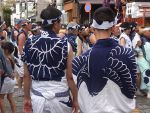 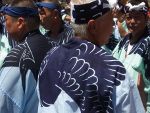 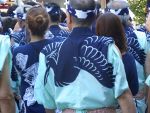
[wombat]
August 4, 2013 14:00
Here is a continuation of the blog "Ginza 5-8-chome Walking I" introduced last time . .
Click here for the previous article. →  /archive/2013/07/post-1716.html /archive/2013/07/post-1716.html
This is the place shown in bold letters in the second half. in the second half.
<line So far >
Ginza Station: Monument of Sukiyabashi ... Toya Kitamura & Toson Shimazaki Monument ... Takuboku Ishikawa poetry monument ... Pedestrian paradise ... Ruins of the commercial law workshop ... Kinharu Yashiki Ruins of Ginza Brick remain Monument ... Monument of Ginza willow ... Shibakuchi Gomon Ruins of Sanumabori Ruins ... Former Japanese National Railways railroad crossing signal at Tokyo Information Center ... Site of Sakujom ...
 Departing from the ruins of Sanjumabori ... Departing from the ruins of Sanjumabori ...
As a continuation of the previous time, three large stones next to the explanation board of the site of Sanjumabori.
These are at the exit of the highway. It's hard to understand.
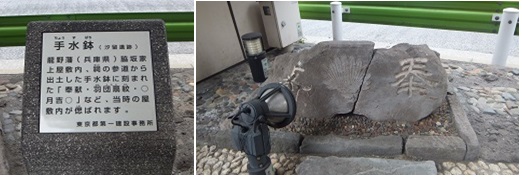
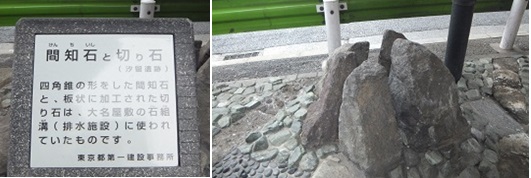

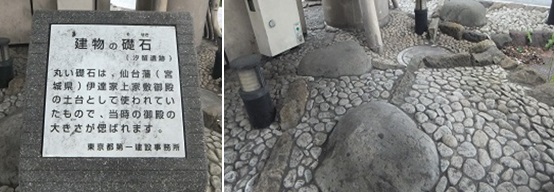
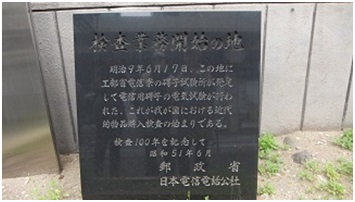
 In Japan In Japan
Land at the beginning of modern goods purchase inspection
In 1876 (1876)
An insulator laboratory in the Ministry of Engineering's telegraph dormitory will conduct an electrical test of electrical insulators for telegraphs here.
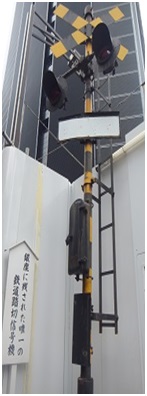
 Former Japanese National Railways Railroad Crossing Signal Former Japanese National Railways Railroad Crossing Signal

 Because there was no representative organization to gather opinions from the Meiji period and domestic business and industrialists, it was extremely difficult to revise the inequality treaty. Therefore, Ito Hirobumi and Shigenobu Okuma request Eiichi Shibusawa to establish a representative organization. Because there was no representative organization to gather opinions from the Meiji period and domestic business and industrialists, it was extremely difficult to revise the inequality treaty. Therefore, Ito Hirobumi and Shigenobu Okuma request Eiichi Shibusawa to establish a representative organization.
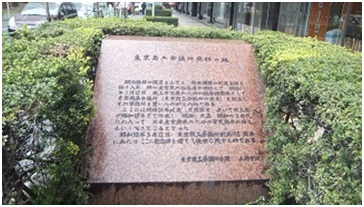
1878, Meiji 11 (1878),
Japan's first Chamber of Commerce
The Tokyo Commercial Code Chamber will be established.
This monument was erected at the birthplace to commemorate the 100th anniversary of its founding.
There is Shimbashi Enbujo on the left side. It's easy to overlook.
 The site of Shozan Sakuma School The site of Shozan Sakuma School
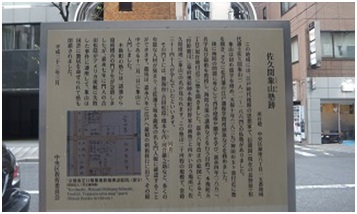
In Kaei era 4 <1851>, he opened a military school to give lectures on military science, artillery, and maritime defense measures.
Kaishu Katsu, Yoshida Shoin, Sanai Hashimoto, Jinnosuke Kawai, etc. gather under the gate, and Ryoma Sakamoto temporarily registers. Kaei era 7 <1854> The school was closed due to American smuggling in Yoshida Shoin.
 The site of Kano Art School The site of Kano Art School
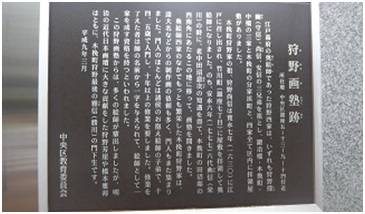
The shogunate's wife. Yotsuya Kano.
He worshiped a mansion in Kajibashi, Kibikicho, Nakahashi and Hamacho. Current Chuo-ku.
It was the Kano family in Kobiki-cho that flourished.
Norinobu Rokudai opened a private school in this area with the knowledge of Onaka Okitsugu Tanuma. Yoshinori Kano and Gaho Hashimoto are from this school.
As mentioned above, it was a walk around Ginza 5-8-chome
1
|
Links
|
 In August 1893, Shohachi Kimura (1893-1958), famous for Kafu Nagai's “Illoha”, a beef shop at 1-1 Yoshikawacho, Nihonbashi-ku (currently Higashi Nihonbashi, Chuo-ku) In August 1893, Iroha was the eighth child of a businessman Shohei Kimura. This year marks the 120th anniversary of birth of the Chinese zodiac sign.
In August 1893, Shohachi Kimura (1893-1958), famous for Kafu Nagai's “Illoha”, a beef shop at 1-1 Yoshikawacho, Nihonbashi-ku (currently Higashi Nihonbashi, Chuo-ku) In August 1893, Iroha was the eighth child of a businessman Shohei Kimura. This year marks the 120th anniversary of birth of the Chinese zodiac sign. This year, the 120th anniversary of his birth, a retrospective exhibition was held at the Tokyo Station Gallery in Chiyoda-ku, next door. Unfortunately, there seems to be no special event in the birthplace of Chuo-ku, where he loved, so on August 21, the day of birth, I thought that it was the former Yokawacho, and hit the street iron I hit the street iron. I played a large kite of a warrior painting that I bought for two yen and fifty yen of a tiger boy who hit a five-sixed nails on the streets of Koyako.
This year, the 120th anniversary of his birth, a retrospective exhibition was held at the Tokyo Station Gallery in Chiyoda-ku, next door. Unfortunately, there seems to be no special event in the birthplace of Chuo-ku, where he loved, so on August 21, the day of birth, I thought that it was the former Yokawacho, and hit the street iron I hit the street iron. I played a large kite of a warrior painting that I bought for two yen and fifty yen of a tiger boy who hit a five-sixed nails on the streets of Koyako. Murai Bank was founded by Kichibee Murai, a native of Kyoto, in 1864 (1864)-1926 (1926). During the Meiji era, Murai was called the "Oriental Tobacco King" due to the privatization of tobacco, and manufactured and sold Japan's first double-cut tobacco "Sunrise" to build a huge wealth. It is said that he competed for advertising with "Tengu tobacco" by Matsuhei Iwaya, Ginza, Tokyo.
Murai Bank was founded by Kichibee Murai, a native of Kyoto, in 1864 (1864)-1926 (1926). During the Meiji era, Murai was called the "Oriental Tobacco King" due to the privatization of tobacco, and manufactured and sold Japan's first double-cut tobacco "Sunrise" to build a huge wealth. It is said that he competed for advertising with "Tengu tobacco" by Matsuhei Iwaya, Ginza, Tokyo.










